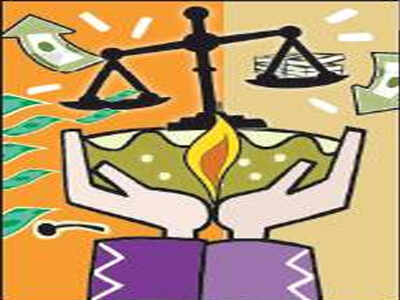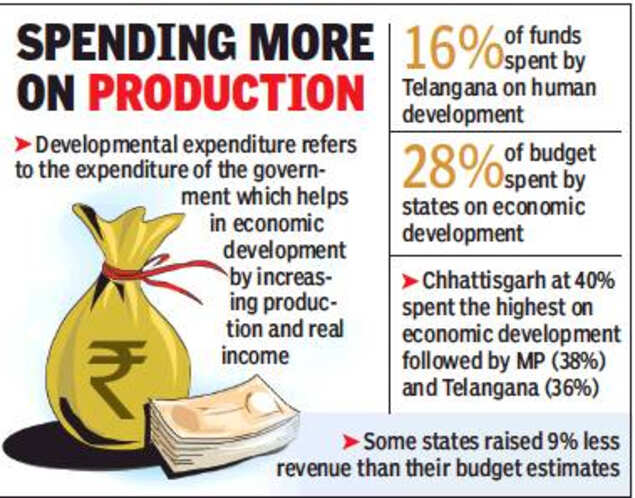
HYDERABAD: Telangana is among very few states in the country which spends higher than the national average developmental expenditure (63%). Between 2015-20, Telangana spent 69% of its funds on developmental expenditure.
Bihar, Chhattisgarh, Delhi, Jharkhand, Karnataka, Madya Pradesh, Odisha and Rajasthan spent more than 70% of their budget on developmental expenditure. Developmental expenditure refers to the expenditure of the government which helps in economic development by increasing production and real income. Experts said developmental expenditure on revenue is divided into developmental expenditure on revenue account and developmental expenditure on capital account.

Budget expenditure has two categories of developmental and non-developmental expenditure. A developmental expenditure helps in increasing the production and productivity of a state’s economy. The developmental expenditure involves both revenue expenditure and capital outlay. This expenditure consists of social services, which includes expenditure on education, health, water supply and sanitation, housing, urban development, and welfare of backward communities,
On the economic front, expenditure includes money spent on agriculture and allied activities, rural development, irrigation, energy, and transportation infrastructure.
Non-developmental expenditure consists of general services, which includes expenditure on administrative services, police and payment of interest and pensions.
In this 2015-18 period, some states raised 9% less revenue than their budget estimates. “In that scenario, states would need to either cut their expenditure or increase their borrowings to compensate for their shortfall in receipts,” an expert said.
Among the four categories of revenue receipts, higher shortfall is seen in grants-in-aid from the centre (22%), and own non-tax revenue (13%). During the 2015-18 period, Assam (25%), Tripura (25%), and Telangana (20%) have seen higher shortfall in revenue as compared to other states. The average revenue receipts of Karnataka have been 2% more than budget estimates.
Bihar, Chhattisgarh, Delhi, Jharkhand, Karnataka, Madya Pradesh, Odisha and Rajasthan spent more than 70% of their budget on developmental expenditure. Developmental expenditure refers to the expenditure of the government which helps in economic development by increasing production and real income. Experts said developmental expenditure on revenue is divided into developmental expenditure on revenue account and developmental expenditure on capital account.

Budget expenditure has two categories of developmental and non-developmental expenditure. A developmental expenditure helps in increasing the production and productivity of a state’s economy. The developmental expenditure involves both revenue expenditure and capital outlay. This expenditure consists of social services, which includes expenditure on education, health, water supply and sanitation, housing, urban development, and welfare of backward communities,
On the economic front, expenditure includes money spent on agriculture and allied activities, rural development, irrigation, energy, and transportation infrastructure.
Non-developmental expenditure consists of general services, which includes expenditure on administrative services, police and payment of interest and pensions.
In this 2015-18 period, some states raised 9% less revenue than their budget estimates. “In that scenario, states would need to either cut their expenditure or increase their borrowings to compensate for their shortfall in receipts,” an expert said.
Among the four categories of revenue receipts, higher shortfall is seen in grants-in-aid from the centre (22%), and own non-tax revenue (13%). During the 2015-18 period, Assam (25%), Tripura (25%), and Telangana (20%) have seen higher shortfall in revenue as compared to other states. The average revenue receipts of Karnataka have been 2% more than budget estimates.
Trending Topics
LATEST VIDEOS
City
 Delhi riots: Video of day 2 violence shows mob attacking cops with sticks, stones
Delhi riots: Video of day 2 violence shows mob attacking cops with sticks, stones  Bharuch: Man caught smuggling liquor in scooter’s footboard, video goes viral
Bharuch: Man caught smuggling liquor in scooter’s footboard, video goes viral  International Women's Day: 14-year-old girl becomes DSP 'for a day' in Maharashtra's Buldhana district
International Women's Day: 14-year-old girl becomes DSP 'for a day' in Maharashtra's Buldhana district  Nirbhaya case: 4 convicts to hang on March 20, says Delhi court
Nirbhaya case: 4 convicts to hang on March 20, says Delhi court
More from TOI
Navbharat Times
Featured Today in Travel
Get the app





